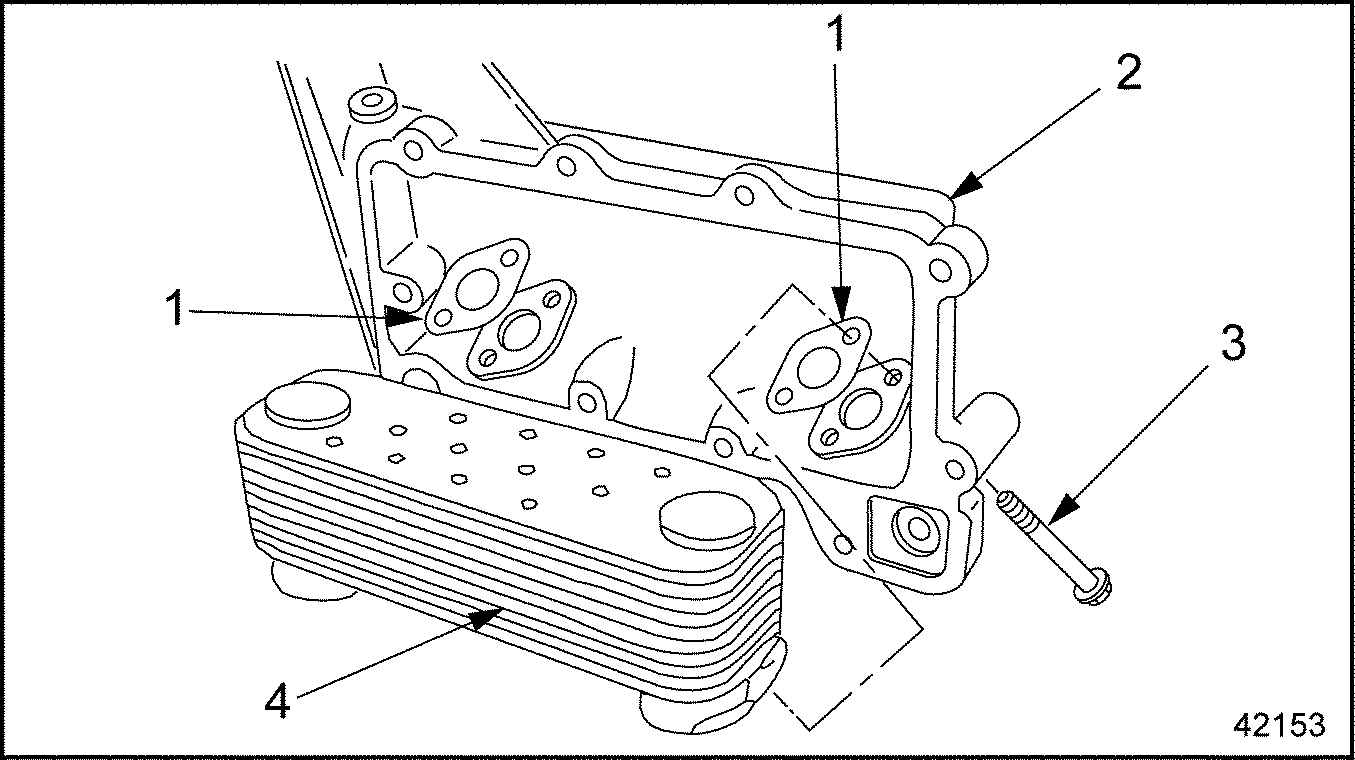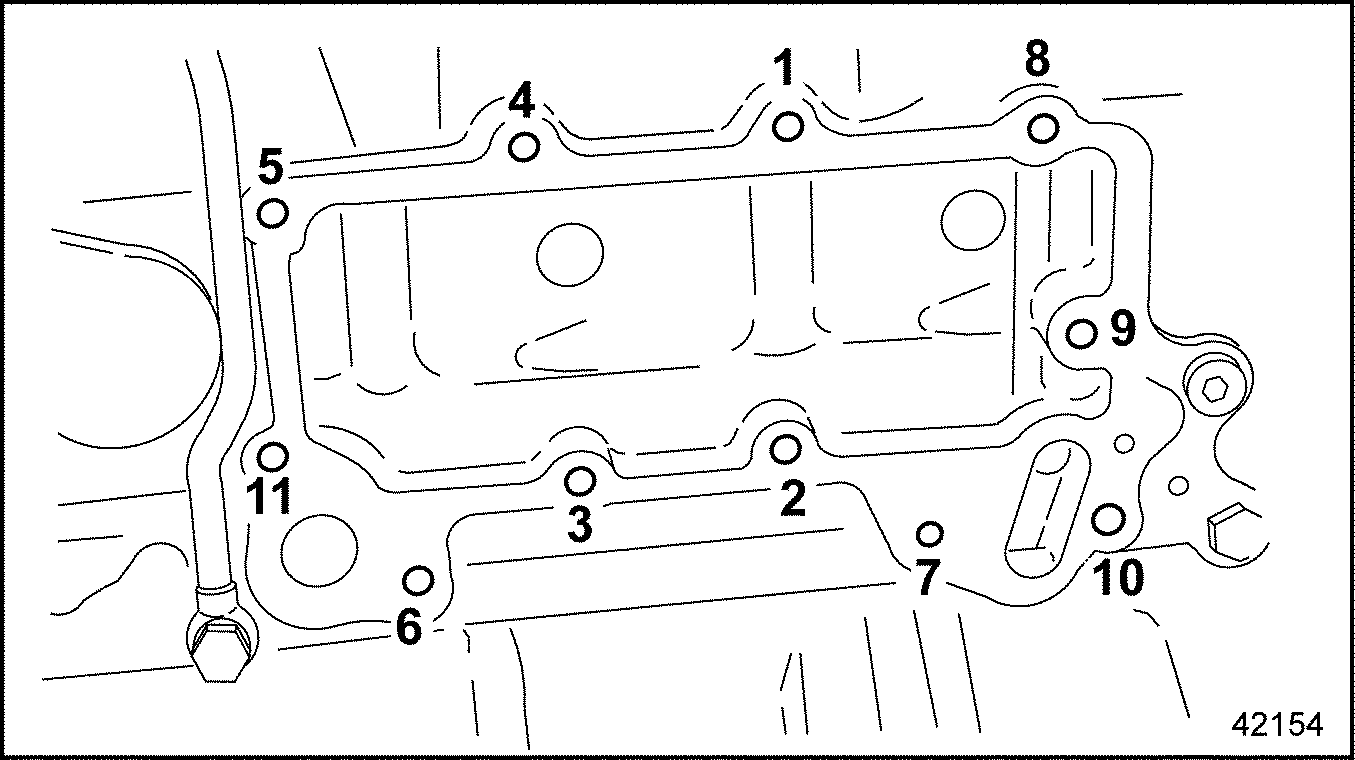Section 3.7
Oil Heat Exchanger/Filter Housing
Perform the following procedures for removal and installation of the oil heat exchanger/filter housing.
Section 3.7.1
Oil Heat Exchanger/Filter Housing Removal
Remove the oil heat exchanger/filter housing as follows:
|
HOT COOLANT |
|
To avoid scalding from the expulsion of hot coolant, never remove the cooling system pressure cap while the engine is at operating temperature. Wear adequate protective clothing (face shield, rubber gloves, apron, and boots). Remove the cap slowly to relieve pressure. |
- When the engine is cool, drain the coolant from the radiator.
- Remove the turbocharger from the engine.
- Disconnect the coolant pump shunt line from the coolant pump inlet pipe and move it out of the way.
- Remove the oil filter cap. Inspect the O-ring and filter for damage and replace them if necessary. Drain the oil remaining in the filter into a clean container.
- Disconnect the wiring harness from the oil pressure/temperature sensor.
- Remove the oil heat exchanger/filter housing from the cylinder block. See Figure
"Oil Heat Exchanger/Filter Housing Removal"
. Catch any oil that drains out in a clean container. Discard the gasket and set aside the housing bolts for later installation.

1. Oil Filter Cap Nut
5. Oil Heat Exchanger/Filter Housing
2. Oil Filter Cap
6. Housing Bolt
3. Oil Filter Housing
7. Gasket
4. Oil Pressure/Temperature Sensor
8. Cylinder Block
Figure 1. Oil Heat Exchanger/Filter Housing Removal
Note: The oil filter housing and the heat exchanger housing are part of the same casting.
- Remove the oil heat exchanger from the oil filter/heat exchanger housing. Discard the gaskets and save the heat exchanger bolts for later installation. See Figure
"Oil Heat Exchanger Assembly (typical)"
.

1. Gasket
3. Oil Heat Exchanger Bolt
2. Oil Filter/Heat Exchanger Housing
4. Oil Heat Exchanger
Figure 2. Oil Heat Exchanger Assembly (typical)
- Remove the oil pressure/temperature sensor from the oil heat exchanger/filter housing. Refer to "3.8.1 Oil Pressure/Temperature Sensor Removal" .
Section 3.7.2
Oil Heat Exchanger/Filter Housing Installation
Install the oil heat exchanger/filter housing as follows:
- Check the oil heat exchanger and the inside of the heat exchanger housing for corrosion, contamination by metal particles, or abrasive material, such as sand.
- If corrosion is found, clean or replace the oil heat exchanger, as necessary.
- Clean the mating surfaces of the oil heat exchanger and heat exchanger housing. Remove any bits of adhering gasket material.
- Install the oil heat exchanger and new gaskets on the heat oil exchanger/filter housing. Tighten the heat exchanger bolts to 25 N·m (18 lb·ft).
- Install the oil filter/heat exchanger housing on the cylinder block. Install the housing bolts and tighten them in the order shown in see Figure
"Tightening Pattern, Heat Exchanger/Oil Filter Housing Bolts"
. Tighten each bolt to 60 N·m (44 lb·ft).

Figure 3. Tightening Pattern, Heat Exchanger/Oil Filter Housing Bolts
- Clean the mating surfaces of the oil heat exchanger/filter housing and the cylinder block. Remove any bits of adhering gasket material.
- Replace the oil heat exchanger/filter housing gasket.
- Install a new filter element and O-ring in the oil filter housing. See Figure
"Oil Filter Assembly"
.

1. Oil Filter Cap
3. Oil Filter Element
2. O-ring
Figure 4. Oil Filter Assembly
- Install the oil filter cap. Tighten the cap nut to 25 N·m (18 lb·ft).
- Install the oil pressure/temperature sensor on the oil heat exchanger/filter housing. Refer to "3.8.2 Oil Pressure/Temperature Sensor Installation" .
- Connect the wiring harness to the oil pressure/temperature sensor.
- Install the turbocharger on the engine. Refer to "6.3.3 Turbocharger Installation" .
- Connect the coolant pump shunt line to the coolant pump inlet pipe.
- Fill the cooling system. Refer to "4.1.1 Cooling System Draining and Flushing"
.

PERSONAL INJURY
Diesel engine exhaust and some of its constituents are known to the State of California to cause cancer, birth defects, and other reproductive harm.
- Always start and operate an engine in a well ventilated area.
- If operating an engine in an enclosed area, vent the exhaust to the outside.
- Do not modify or tamper with the exhaust system or emission control system.
- Start the engine. Check the gauge for the correct oil pressure; check the oil lubrication system and the coolant pump inlet pipe for leaks. The correct oil pressures are listed in Table
"Engine Oil Pressures"
.
Engine Speed
Minimum Pressure – kPa (psi)
At idling rpm
50 (7.0)
At maximum rpm
250 (36.0)
Table 6. Engine Oil Pressures
| MBE 4000 Service Manual - 6SE412 |
| Generated on 10-13-2008 |